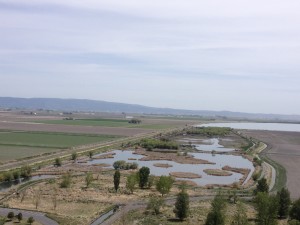By Chris Winters, The Herald
TULALIP — A lawsuit filed against the state Department of Fish and Wildlife has led the state to cancel this year’s entire release of hatchery-raised steelhead trout into Western Washington rivers.
That means that there will be virtually no steelhead fishing in 2016 and 2017.
This week the Tulalips and other local American Indian tribes weighed in, blasting the decision by the state to cancel the release, and the lawsuit that forced the move, filed by the Wild Fish Conservancy, a nonprofit based in Duvall.
The suit was filed on March 31. In a declaration filed April 16 by Phil Anderson, the director of Fish and Wildlife, he wrote that the department’s plan to protect wild steelhead from genetic hybridization with hatchery fish is under review by the National Marine Fisheries Service, but that he had no expectation it would be approved in time for the release.
That approval is necessary so that the program wouldn’t run afoul of the Endangered Species Act, which lists wild steelhead as threatened. Therefore, Anderson decided there would be no steelhead release this year.
A joint statement issued by the Tulalip Tribes, the Lummi Nation and the Upper Skagit Tribe took issue with the basis for the nonprofit’s lawsuit, which, it said, “erroneously concluded that hatchery production, rather than the loss of habitat, is responsible for the depressed state of the Puget Sound steelhead populations.”
The statement from the tribes urged anglers to contact Gov. Jay Inslee, the Fish and Wildlife Commission, and Anderson and to put pressure on the department.
“Maybe the hatcheries do have some impact, but there are greater impacts out there,” said Ray Fryberg, executive director for natural and cultural resources for the Tulalip Tribes.
Habitat loss, environmental change, perhaps even seals waiting at the mouths of rivers to eat the returning fish probably have a greater impact on wild populations than the hatcheries do, Fryberg said.
The fish at issue is known as Chambers Creek steelhead, a strain raised in six hatcheries in Western Washington, including the Whitehorse Ponds hatchery near Darrington.
The hatchery-raised juveniles are released earlier than when wild steelhead hatch, and the difference in timing allows the hatchery-raised adult steelhead to be fished before the wild runs return to their spawning grounds.
A spokesperson for the Department of Fish and Wildlife declined to comment on the lawsuit or the statement from the tribes.
The conservancy’s suit alleges that the state’s hatchery programs allow Chambers Creek steelhead to interbreed with the wild strains, out-compete the wild fish for food and spawning grounds, and that the hatchery operations themselves have suppressed the wild population.
The wild stocks are so depressed that they are in danger of being listed as endangered, which would drastically affect fishing for all salmonid species in the region, said Kurt Beardslee, the executive director of the Wild Fish Conservancy.
Loss of habitat is a critical issue, Beardslee said, but the only two actions that would have an immediate impact on wild populations would be to curtail fishing or to stop hatchery releases.
He cited a recent study conducted in the Skagit River of the impacts of hatchery-raised steelhead on the wild population, one of whose recommendations was to suspend hatchery releases for seven to 10 years to eliminate competition among the species, reduce cross-breeding among populations and increase the survival rate of wild steelhead.
“We have to look at things that can get results immediately,” Beardslee said.
Fryberg said that the lawsuit was a step backward in the struggle to restore wild runs of steelhead and salmon.
“For years and years as co-managers and cooperative managers we’ve always emphasized that we should be working together,” Fryberg said.
With the environment changing rapidly, there is simply no baseline condition to compare it to, and it’s essential to get all the scientific data on the table before acting, he added.
“We have not fished some native runs of fish out here for 20 to 30 years and they still haven’t rebounded,” Fryberg said. “Let’s not run into this hastily.”


